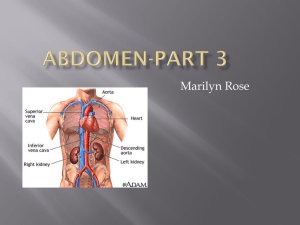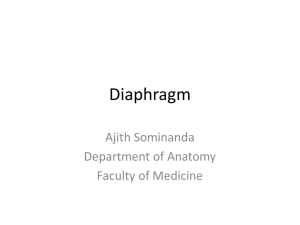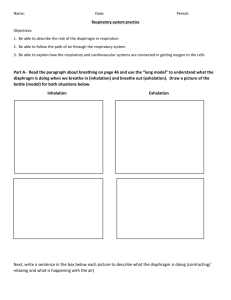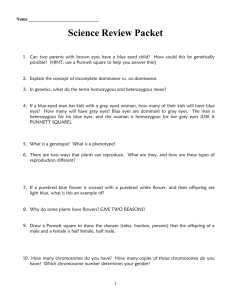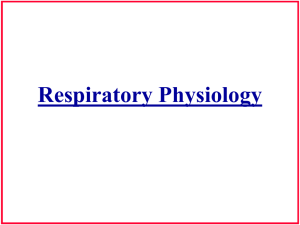Obs and Gynae 3 Diaphragm lift technique 1
advertisement
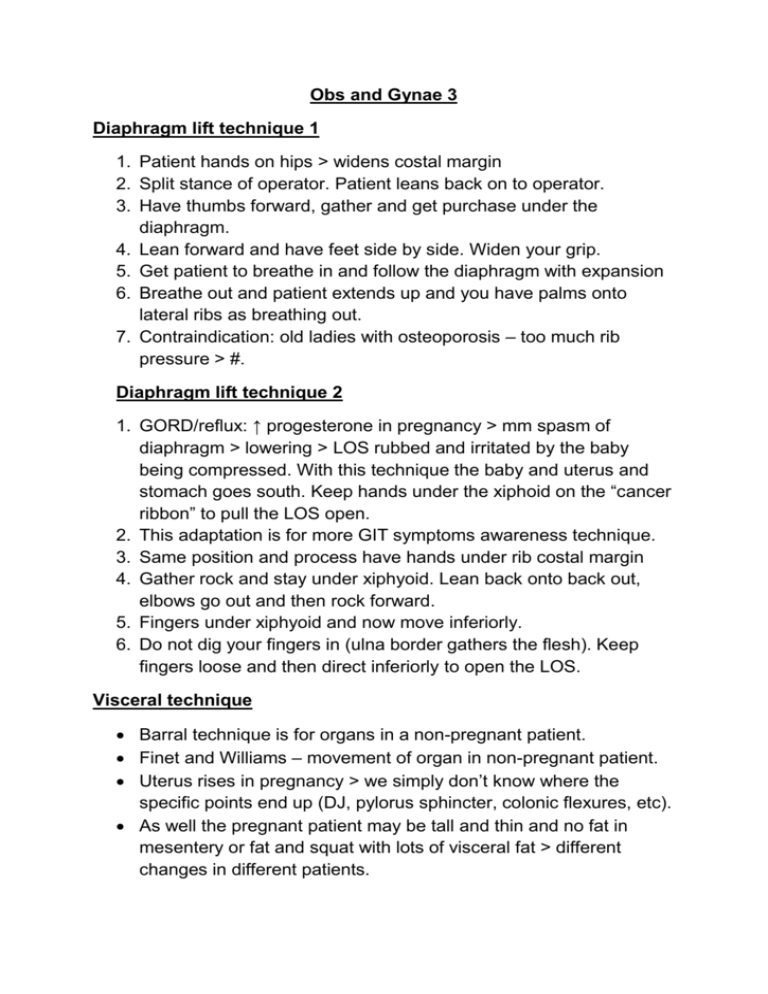
Obs and Gynae 3 Diaphragm lift technique 1 1. Patient hands on hips > widens costal margin 2. Split stance of operator. Patient leans back on to operator. 3. Have thumbs forward, gather and get purchase under the diaphragm. 4. Lean forward and have feet side by side. Widen your grip. 5. Get patient to breathe in and follow the diaphragm with expansion 6. Breathe out and patient extends up and you have palms onto lateral ribs as breathing out. 7. Contraindication: old ladies with osteoporosis – too much rib pressure > #. Diaphragm lift technique 2 1. GORD/reflux: ↑ progesterone in pregnancy > mm spasm of diaphragm > lowering > LOS rubbed and irritated by the baby being compressed. With this technique the baby and uterus and stomach goes south. Keep hands under the xiphoid on the “cancer ribbon” to pull the LOS open. 2. This adaptation is for more GIT symptoms awareness technique. 3. Same position and process have hands under rib costal margin 4. Gather rock and stay under xiphyoid. Lean back onto back out, elbows go out and then rock forward. 5. Fingers under xiphyoid and now move inferiorly. 6. Do not dig your fingers in (ulna border gathers the flesh). Keep fingers loose and then direct inferiorly to open the LOS. Visceral technique Barral technique is for organs in a non-pregnant patient. Finet and Williams – movement of organ in non-pregnant patient. Uterus rises in pregnancy > we simply don’t know where the specific points end up (DJ, pylorus sphincter, colonic flexures, etc). As well the pregnant patient may be tall and thin and no fat in mesentery or fat and squat with lots of visceral fat > different changes in different patients. Barral - hands go where the bodies tell you where the organ is. Not good enough for Sandler….”get over it Steve!” Motility technique is not useful for the pregnant patient. Motility, according to Barral, is the inherent movement/energy in an organ related to the embryological migration of organs. Mobility technique is the relation of organs to MSk and somatic structures via attachments. Motricity is the movement of organs in relation to active movements. As the baby grows > uterus expands and these fascial attachments stretch and relaxed, therefore need relaxin to allow this. Adhesion between the sliding surfaces are common. Fluid comes from the lymph fluid and from the serous membranes. This can be encouraged through valsalva and pelvic floor contraction > fluid can be actively pushed via this type of treatment. This is not motility TTT. Kidney motility is inspir and expir, but mobility is inferior and superior. For a pregnant lady with diaphragmatic changes and the kidney being retroperitoneal > changes in the way you can treat the kidney. This will not work with motility if the mobility is the thing you want to treat. Barrel here is too limited. Caecum > squeezing wet mud continuously against gravity. Very active and the hardest working part of your gut. Caecum is constipated part of gut and descending colonic flexure is diarrhoea part of gut in terms of biomechanics and gravity. 4 ligaments here laterally on each side – hepatic flexure and splenic flexure. Medially the mesocolon anteriorly and the toldt’s fascia posteriorly. Hepatic flexure at 10th rib – 4 peritoneal thickenings here (diaphragm/1oth rib/gall bladder duodenum/stomach. Restriction here > stasis in caecum being pushed against pelvic wall > posterior and lateral > squeezing fluid out > dry area which becomes sticky and adherent. An adhesion is viscous to viscous dryness. Constipation is common here > squeezing rectum > varices in rectum > possible vaginal varices. Osteopathic manipulations > adhesions release in pregnancy. Pure mobility as it is related to pregnancy. Uterus rises > moves to right guided by sigmoid > siting on the sigmoid > MSk elements and structure can become rigid and solid. More movement in the organ > more potential for health. Can affect through MSk elements > release attachments. Transverse mesocolon rises. Diaphragm becomes dome shaped lifting the mesocolon with it. Affect the diaphragm as pregnancy affects upper rib breathing. Liver goes onto right abdominal wall and restricted in pregnancy high up and lateral > mobility restricted. Stomach compressed and moves to the left abdominal wall. Heart moves 15° Left. Pituitary gland enlarges by 40% Relaxin appears in cycle in premenstrual stage to relax the cervix for 6 hours other than in pregnancy. GORD Baby and fat in mesentery > GORD due to oestrogen & relaxin. Cardiac sphincter loosens. Small stomach size due to inferior compression up with the same size meals. Best to eat lest and more often, or go for a walk after a meal. Poor posture > slumping after meals. Vomitting: 8% get hyperemesis gravidarium Morning sickness: no one knows why. Blood sugar is lowest in the morning. This triggers “I need food” > nausea. Energy used to get her around in the morning. No more energy > if excess nausea > vomit. He says take a flat coke at night when she gets up for a pee helps with morning sickness – need high sugar content. Heliobacter pylori > destroys the stomach lining > ulceration & bleeding > ↑ risk of cancer. LOS does not have a mucous lining > cell changes. GORD in babies: ventuse or occipital birthing trauma > high palate > poor seal over nipple > not feeding properly > half water and half milk > GORD > screaming due to immature diaphragm. Not caused by a hairy baby, pressure on a nerve, diet, toxaemia of pregnancy. Principles; dietary advice, C2 on left, Diaphragm, Rib flaring (diaphragm etc), Reflux direct relations (eg diaphragmatic technques), Viscero-somatic relations into TSp (dog/ST techs/artic). 1. Diet – raw foods with skins on should be avoided. Meat/fish should be casseroled or poached (not roasted or fried). Avoid gassy drinks & acids in food/drinks. Small meals and more often (main meal is midday – afternoon the food will drain when you are vertical. In evening the food will take longer to pass when she is sitting down – have soup and ice cream - family relations and getting fats and nutrients). 2. C2-T2 pattern: viscera-somatic reflex on Left C2 from reflux/oesphagitis/indigestion (upper GIT reflex) – iliocostalis cervicis T2 > C2. Cervical plexus C1/C2 has twig to vagus nerve which is secretomotor to stomach (SYMPS?). Reason is LOS irritation > T2 muscles hypertonicity. Muscle relation to C2 via iliocostalis. C2 has relation to vagus via communicating nerve > irritation of stomach acid > Sympathetic stimulation of T2? TTT of C1/C2: mid lever midrange HVT Flex head with belly. Side shift to analyse CSp. First MTP is applicator with hand going round ear. Keep flexion and chin on chest. Go round and sit on corner of table introduce ROT. Keep tension in side shift. Thumb toward mouth. ROT thrust in line of mouth. Be careful with SB thrusts in upper cervicals as the brainstem access is here and a shockwave could occur into the brainstem here. Constipation in pregnancy Reasons: relaxation of smooth muscle; long transit time; calcitol increase calcium absorption from gut > increased iron deposits > constipation; caecum ptosis. Prototcol: diaphragm/ribs & hepatic (10th rib L) and splenic flexures (9th rib R). Visceral thrust techniques, caecum functional technique. Visceral adhesiosn: TTT is to separate the two parts of the adhesion > fluid flow between the two. This is not the same as a surgical adhesion. This is a visceral adhesion. TTT of caecum: ASIS & umbilicus draw line: 3 fingers of patient to iliocecal valve from ASIS. Descend down to the ileum posterior to caecum on medial border with fingers of both hands. Take little finger along lateral border of caecum. Feel where the resistance = caecum. Put a shockwave through the caecum along the lateral wall / border of the pelvis using reinforced fingers. Repeat the technique to feel a release. Vibrational technique.
